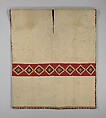Tunic with Diamond Band
Not on view
Tunics with a diamond-pattern at the waist are one type of some half-dozen standardized designs known from the Inca Empire, the polity that dominated much of western South America in what is known as the Late Horizon period (AD 1470–1532). This tunic features a white ground interrupted by a red band at the waist containing eight stepped diamond shapes on each side. White tunics were particularly highly esteemed by the Incas, as white camelids were comparatively rare in the Andes.
Inca tunics display remarkably little variation in size, suggesting an extreme control over production. Fine cloth was woven by the acllas, the “chosen women” of the Inca, but it was also produced by full-time professional weavers who worked in the service of the Inca emperor or other important lords. The finest cloth, known as cumbi, could have as many as three hundred finely spun and dyed weft yarns per inch densely packed over equally fine three-ply warps. It is one of the mind-blowing facts of Andean weaving that such seemingly delicate yarns have the tensile strength and abrasion resistance to be transformed into dense weft-face cloth.
Inca tunics were tapestry woven as a single panel with single-interlocking joins. The finished garment has, therefore, four identical faces in a supple but firm cloth with a subtle sheen. While on the loom, the neck slit was held closed by a temporary weft yarn that was removed after the weaving was complete. Once the finished weaving was cut from the loom, all seams and selvage edges were completely covered with fine double-faced embroidery. The seams were concealed with a precisely repeated series of multicolored bands of different heights. Along the bottom, just above similarly embroidered bands that cover the weft selvage, a zigzag was created with multicolored yarns. The precise meaning of this zigzag line is unknown, but it was of such importance that it was included in depictions of royal tunics in one of the earliest illustrated manuscripts concerning the Inca Empire, that of Felipe Guaman Poma de Ayala, completed circa 1615.
Finely woven tunics were signifiers of high status in the Andes since at least the first centuries AD. Known as uncu in the language of the Incas (an ancestor of the present-day Quechua language), such garments were the primary element of men’s attire in the Andes. Tunics were more than status symbols, however, as they were very closely associated with concepts of identity and history. Spanish chronicles of the 16th century relate that during funerary and memorial rituals, courtiers would hold aloft the tunics of a deceased Inca king and tell of the ruler’s great deeds: the garments were considered testaments or witnesses to historical events. Sixteenth-century chroniclers also record that Inca rulers bestowed fine tapestry tunics on warriors who distinguished themselves on the battlefield. Uncus, furthermore, were given as diplomatic gifts, part of a sophisticated strategy of imperial control. Ownership and use of tapestry tunics were tightly controlled: only those recipients who would have been honored with such gifts would be allowed to wear them.
Faint creases on this tunic reveal that it was once folded in sixteenths, the customary way to store fine garments. Carefully placed in stone boxes or other containers, such tunics were often passed down from generation to generation, precious heirlooms that speak to the masterful weaving traditions of the Andes.
Joanne Pillsbury, Andrall E. Pearson Curator, and Christine Giuntini, Conservator 2021
References and Further Reading
Abal de Russo, C. M. (2010). Arte textil incaico en ofrendatorios de la alta cordillera andina. Fundación Ceppa.
Cummins, T.B.F. (1994). Representation in the Sixteenth Century and the Colonial Image of the Inca. In E. H. Boone y W. D. Mignolo (Eds.) Writing Without Words, Alternative Literacies in Mesoamerica and the Andes, pp. 205-208. Duke University Press.
Cummins, T.B.F. (1998). Let Me See! Reading is for Them: Colonial Andean Images and Objects ‘como es costumbre tener los caciques señores. In E. Boone y T. Cummins (Eds.) Native Traditions in the Postconquest World. A Symposium at Dumbarton Oaks, 2nd through 4th October 1992, pp. 91-148. Dumbarton Oaks Research Library and Collection.
Guaman Poma de Ayala, F. (1980 [1615]). El Primer Nueva Corónica y Buen Gobierno, J. V. Murra y R. Adorno (Eds.); J. L. Urioste (Transl.), 2nd ed., 3 vols. Siglo Veintiuno.
Murra, J. V. (1962). Cloth and Its Function in the Inka State. American Anthropologist 64, pp. 710-728.
Phipps, E., J. Hecht, y C. Esteras Martín (Eds.), The Colonial Andes: Tapestry and Silverwork, 1530-1830. The Metropolitan Museum of Art.
Pillsbury, J. (2002). Inka Unku: Strategy and Design in Colonial Peru. Cleveland Studies in the History of Art 7, pp. 68-103.
Pillsbury, J. (2020). El Uncu Inca: Tradición y Transformación. In R. Mujica (Ed.), Arte imperial inca. Sus orígenes y transformaciones desde la conquista a la independencia. Banco de Crédito.
Rowe, J. H. (1979). Standardization in Inca Tapestry Tunics. In A. P. Rowe, E. P. Benson and A.L. Schaffer (Eds.), The Junius B. Bird Pre-Columbian Textile Conference May 19th and 20th, 1973, pp. 239-264. The Textile Museum.
Rowe, J. H. (1999). Estandarización de las túnicas tapiz Inca. In J. A. de Lavalle y R. de Lavalle de Cárdenas (Eds.) Tejidos Milenarios del Perú/Ancient Peruvian Textiles, pp. 571-664. Apu Series. Integra.
Rowe, A. P. (1978). Technical Features of Inca Tapestry Tunics. Textile Museum Journal, 17, pp. 5-28.
Rowe, A. P. (1997). Inca Weaving and Costume. The Textile Museum Journal 1995-1996, 34-35, pp. 4-54.
Due to rights restrictions, this image cannot be enlarged, viewed at full screen, or downloaded.
This artwork is meant to be viewed from right to left. Scroll left to view more.



